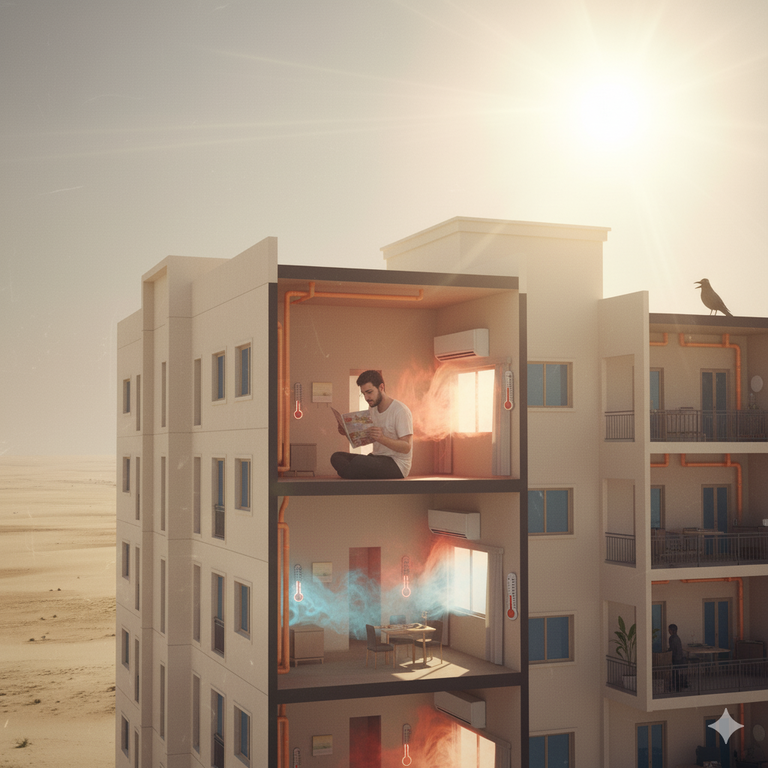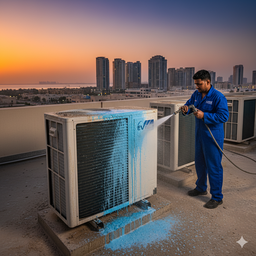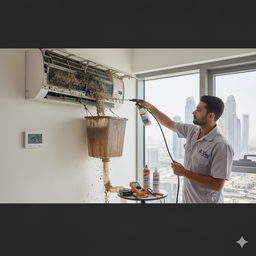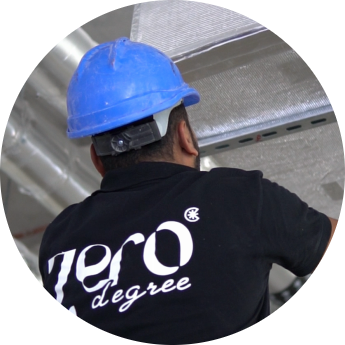The relentless heat and humidity of Abu Dhabi make a functioning air conditioning system an absolute necessity, not a luxury. HVAC (Heating, Ventilation, and Air Conditioning) units here operate almost constantly, placing them under immense stress that systems in milder climates never face. This constant, high-demand operation, combined with unique environmental factors, creates a perfect storm for frequent breakdowns, reduced efficiency, and a host of common problems that residents must constantly manage.
Understanding the root causes of AC issues in Abu Dhabi involves looking at three primary areas of strain: the extreme climate, the impact of environmental contaminants, and the cumulative effects of mechanical wear and tear often exacerbated by neglect.
I. The Unrelenting Pressure of the Climate
The geographical location of Abu Dhabi—a coastal city in a desert environment—subjects AC units to a specific and potent combination of atmospheric stresses that significantly reduce their lifespan and cooling efficiency.
Extreme High Temperatures and Overexertion
The most immediate cause of AC system failure is the sheer intensity of the heat. During the peak summer months, outdoor temperatures soar well beyond 40∘C (104∘F). An air conditioner works by absorbing heat from indoors and expelling it outdoors through the condenser coils.
- Reduced Heat Dissipation: When the outside temperature is extremely high, the temperature difference (or delta-T) between the refrigerant in the condenser coils and the surrounding air is drastically reduced. The unit must work much harder and run for significantly longer cycles just to release the heat it has absorbed. This process is inherently inefficient in high-heat conditions.
- Overheating and Compressor Failure: The relentless operation under extreme load causes the central components, particularly the compressor (the ‘heart’ of the AC system) and the motors, to overheat. This constant thermal stress accelerates wear and tear on electrical and mechanical parts. Overheating can lead to system shutdown (short-cycling) as a protective measure or, in severe cases, the complete, expensive failure of the compressor or motor.
- Power Grid Stress and Electrical Issues: Extreme heat prompts every residence and commercial building to crank up their AC simultaneously, putting a massive strain on the local power grid. This high demand can lead to power fluctuations, surges, or even brownouts, which can trip circuit breakers, blow fuses, and damage sensitive electrical components like capacitors and wiring in the AC unit.
High Humidity and Water-Related Problems
Abu Dhabi’s proximity to the Arabian Gulf introduces a significant humidity factor, which presents its own set of problems for AC systems.
- Clogged Condensate Drain Lines: As the AC removes humidity from the indoor air, it creates condensation. This water is collected in a drain pan and flows out through a condensate drain line. High humidity, however, fosters the rapid growth of algae, mold, and sludge within these drain lines, leading to frequent and severe blockages. When the line clogs, the water backs up, often resulting in visible water leaks from the indoor unit, potentially causing damage to ceilings and walls.
- Increased Cooling Load: High humidity makes the indoor environment feel much hotter than the thermostat might indicate, forcing the AC to work harder to achieve a comfortable temperature. The unit must expend extra energy not just to lower the air temperature but also to dehumidify the air. This dual workload increases the operational stress on the system.
- Frozen Evaporator Coils: Paradoxically, high humidity can contribute to frozen indoor coils. This typically happens when the airflow is restricted (due to a dirty filter or blocked duct), but the moisture in the air condenses and freezes on the super-cold coils. Once frozen, the coils cannot absorb heat, the system blows warm air, and the subsequent thawing of the ice causes significant water leakage.
II. The Battle Against Environmental Contaminants
The desert environment and rapid urban development of Abu Dhabi introduce constant airborne contaminants that plague AC systems and are a major factor in efficiency loss and mechanical failure.
Sand, Dust, and Air Filter Clogs
Abu Dhabi’s environment is inherently dusty, with frequent winds and occasional sandstorms pushing fine desert sand into every crevice. AC systems are designed to filter airborne particles, but the sheer volume of dust and sand is overwhelming.
- Rapid Filter Blockage: Air filters, the AC’s first line of defense, become saturated and clogged with sand and dust much faster than in other climates. Experts recommend checking and replacing filters monthly during peak seasons. A clogged filter dramatically restricts airflow over the evaporator coil.
- Weak Airflow and Freezing: Restricted airflow forces the blower motor to work harder, yet results in weak or warm air coming from the vents. More critically, the restricted airflow can lead to the aforementioned freezing of the evaporator coils, triggering a system malfunction.
- Coil Insulation and System Overload: Dust and sand that pass the filter eventually settle on the indoor evaporator coils and, even more critically, on the outdoor condenser coils. This coating acts as an insulator, preventing the coils from properly exchanging heat. The evaporator coil can’t absorb heat from indoors, and the condenser coil can’t release heat outdoors. This loss of heat-exchange efficiency causes the system to work longer and harder to achieve the desired cooling, directly leading to increased energy consumption and premature component failure.
Salt Corrosion in Coastal Areas
For buildings located near the coast, the air carries moisture mixed with salt, creating a corrosive environment that specifically attacks the outdoor condenser unit.
- Condenser Damage: Salt buildup on the condenser coil fins and casing accelerates rust and corrosion. This damage compromises the structural integrity of the fins, making them brittle and further reducing the unit’s ability to dissipate heat, thereby exacerbating all heat-related problems.
- Electrical Component Failure: Corrosive elements can also attack exposed wiring and electrical connections in the outdoor unit, leading to short circuits, system tripping, and failure of critical components like contactors and capacitors.
III. Preventable Failures: Maintenance and Installation Factors
While the climate and environment are unavoidable challenges, a significant portion of AC issues stem from human-controlled factors related to installation and maintenance.
Lack of Regular and Deep Maintenance
In an environment as challenging as Abu Dhabi, routine maintenance is not optional—it is critical to the system’s survival. Neglecting scheduled AC servicing almost guarantees a system breakdown.
- Neglected Component Health: Annual or bi-annual deep cleaning, often called ‘AC Deep Cleaning’ or ‘Service Contract,’ is essential to fully clean the evaporator and condenser coils, flush the drain lines, and inspect electrical components. Skipping this allows dirt and algae to solidify, leading to total blockages, mold growth, and permanent efficiency loss.
- Refrigerant Leakage: Low refrigerant charge is a major cause of insufficient cooling. Leaks often develop over time due to normal wear and tear and the constant expansion and contraction of pipes in extreme temperatures. Maintenance checks are necessary to detect and repair these leaks before they cause catastrophic compressor failure, which is a costly consequence of running a system low on refrigerant.
- Ductwork Issues: Leaky, damaged, or poorly sealed air ducts can allow cooled air to escape into false ceilings or non-conditioned spaces, forcing the AC to run continuously without properly cooling the room. Unsealed ducts can also draw in dust and contaminated air, which fouls the system.
Installation and System Sizing Errors
Even a perfectly maintained unit will struggle if it was not correctly selected and installed to handle the specific load of the Abu Dhabi climate.
- Undersized Units: A common issue is installing an AC unit that is too small (undersized) for the area it is meant to cool. An undersized unit will run non-stop (continuously cycling) in a fruitless attempt to meet the thermostat setting. This constant operation rapidly burns out components and leads to excessive energy bills.
- Improper Thermostat Placement: If the thermostat is installed on a wall that receives direct sunlight or is near a significant heat source (like an oven or a window), it will misread the room temperature, causing the AC system to either overcool or short-cycle erratically, leading to discomfort and energy waste.
Conclusion
The high frequency of air conditioning problems in Abu Dhabi is a direct consequence of a synergistic assault on the system: extreme heat that pushes mechanical limits, high humidity that causes corrosive and drainage issues, and a dusty, sandy environment that chokes airflow and insulates heat-exchange surfaces. The combined result is a perpetually overtaxed system prone to premature failure.
For residents and building managers in Abu Dhabi, a proactive approach to HVAC care is the only viable strategy. This means moving beyond simple filter changes to embrace regular, professional deep cleaning and comprehensive maintenance checks that address the specific, localized environmental challenges. In this demanding climate, an AC unit is a critical piece of infrastructure, and its maintenance must be treated as such to ensure continuous comfort and avoid expensive breakdowns.








Leave a Reply